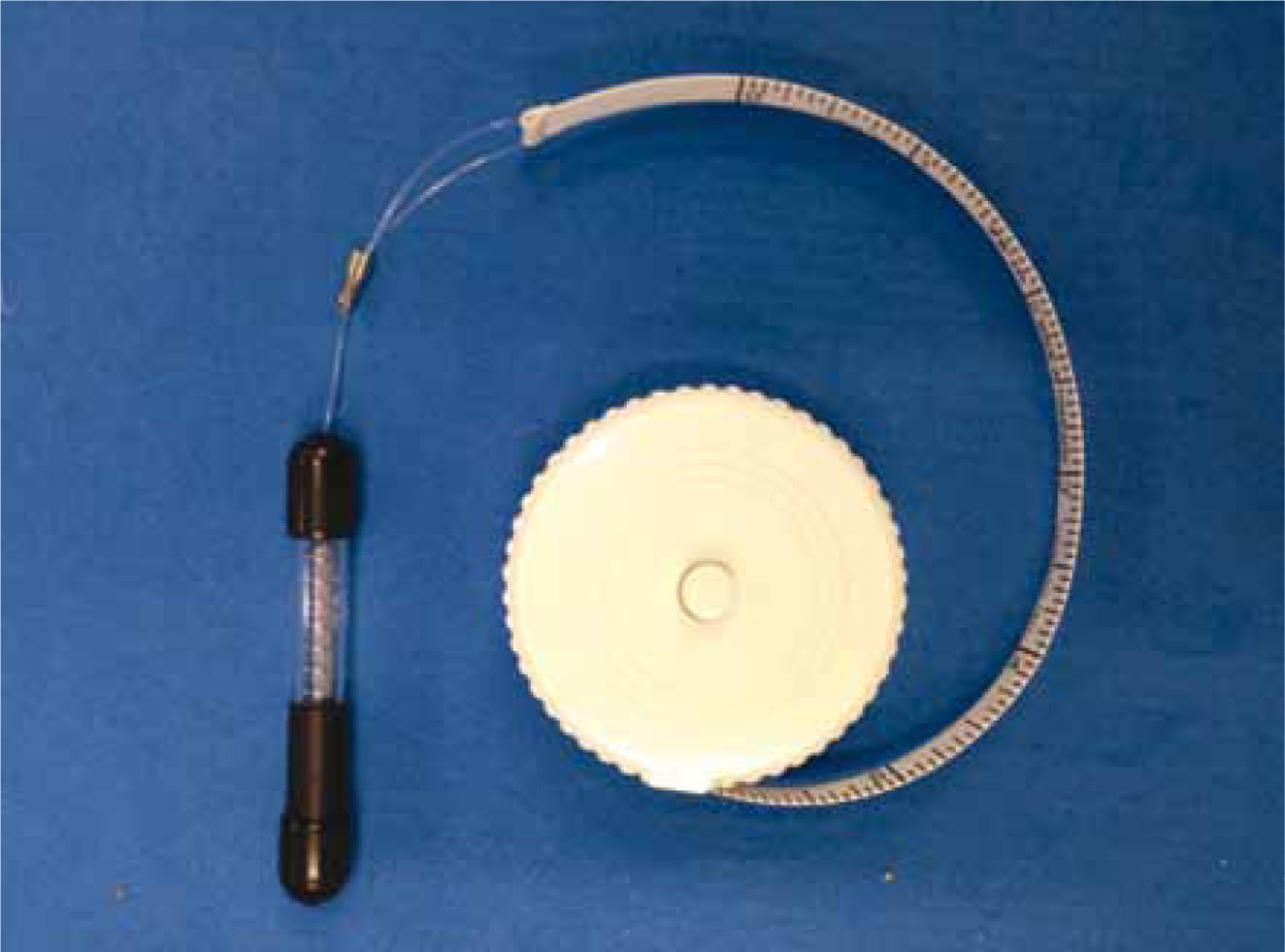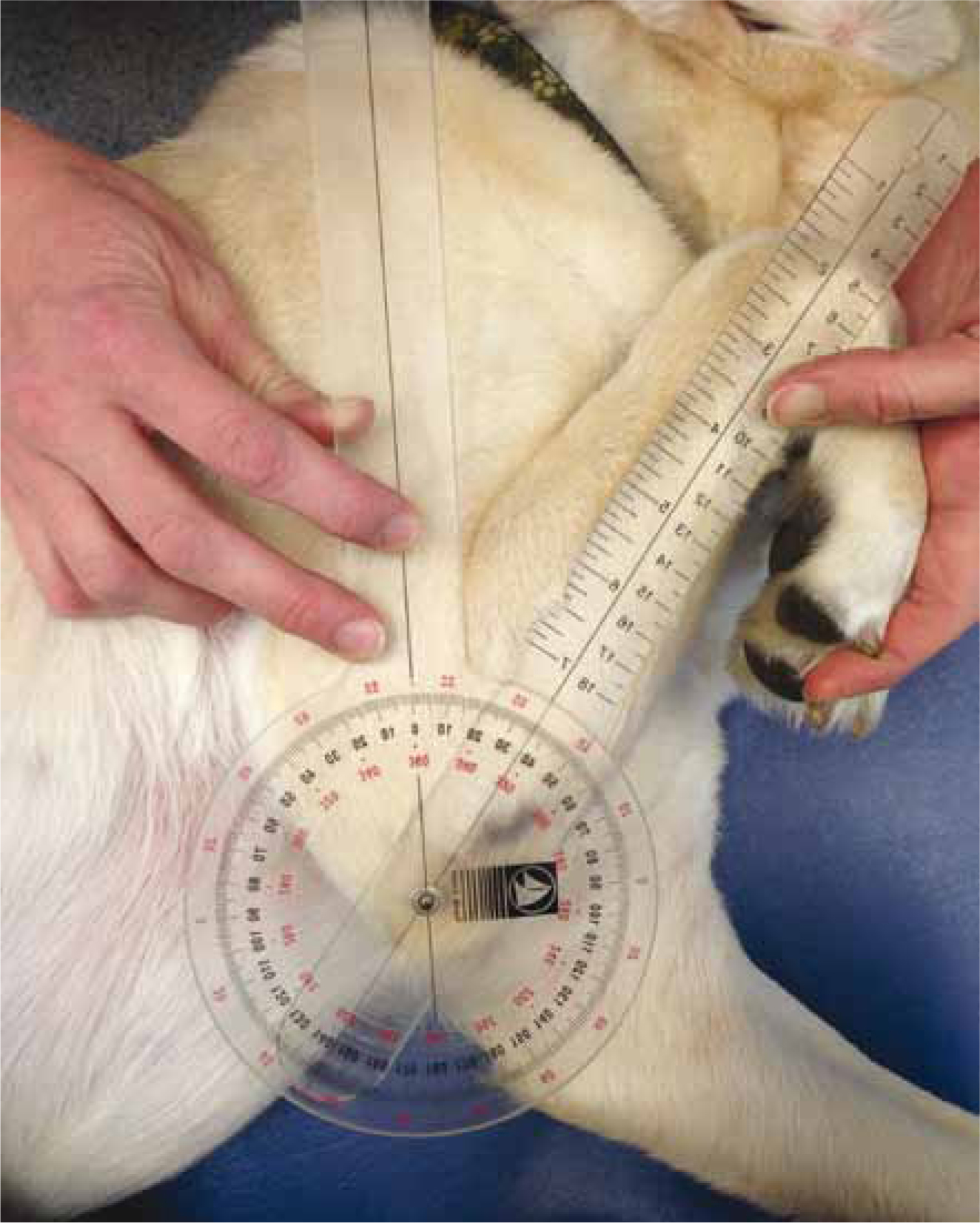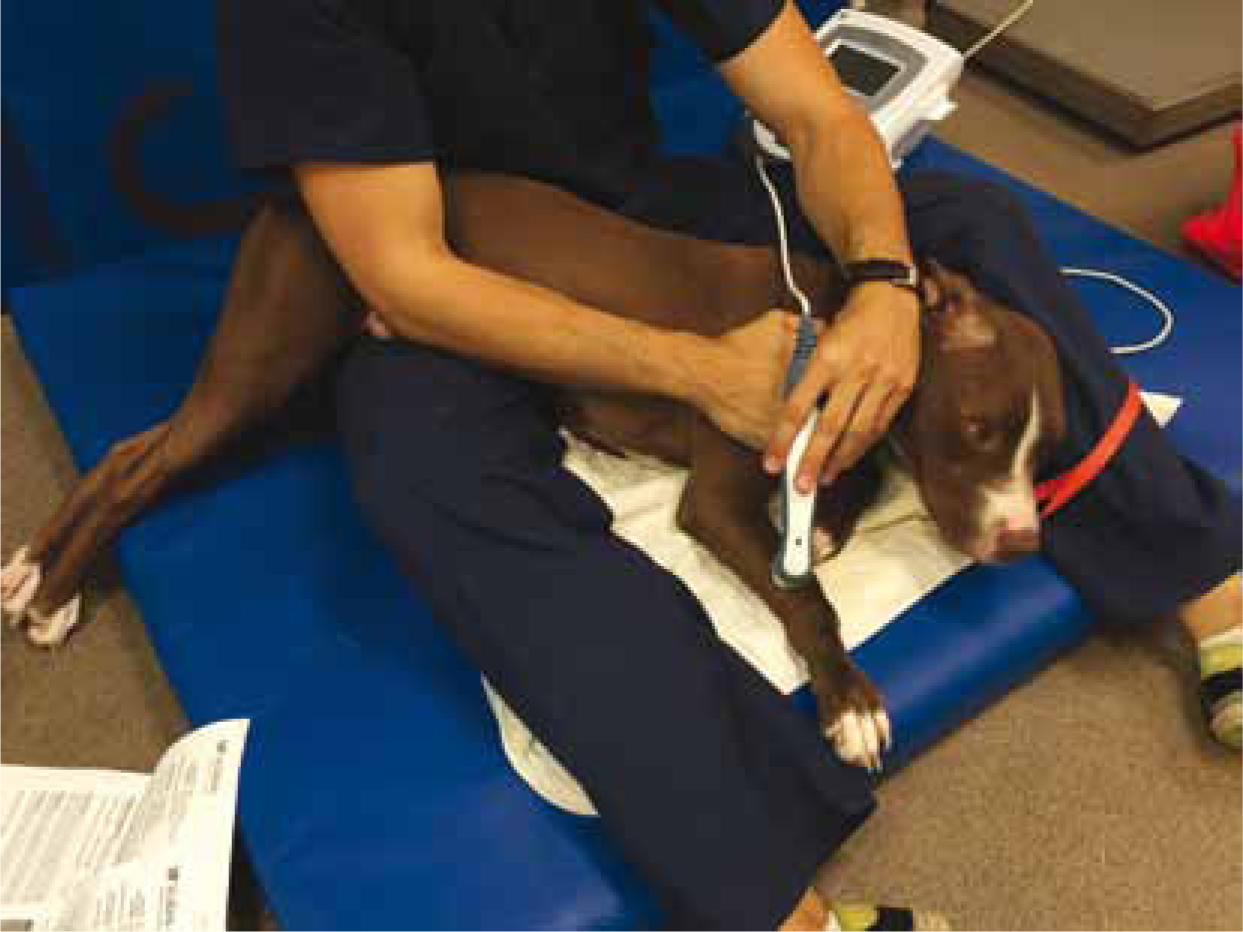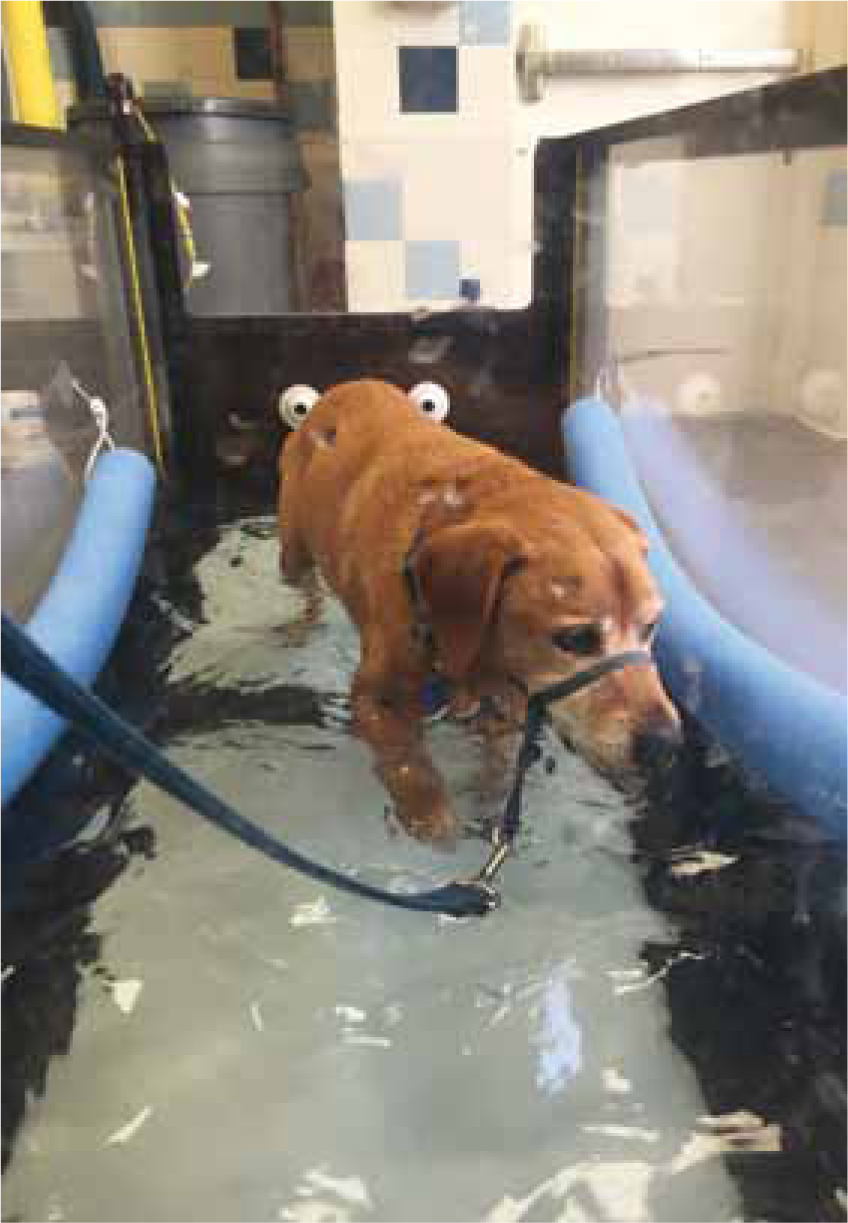Pain management for the physical rehabilitation patient, whether post operative, post injury, because of a disease state or because of the aging process, is absolutely vital to recovery. Optimum pain management will help ensure that the patient is cooperative and willing to participate in the programme designed by the physiotherapist. A painful patient will resist not only the exercise programme designed, but is likely to resent touching possibly even trying to aggressively bite the veterinary nurse. In the USA veterinary technicians can become certified in physical rehabilitation and work alongside veterinary physiotherapists. This article discusses the role of the certified physiotherapist technician, as well as pain management in physical rehabilitation.
It is imperative that the patient that undergoes physiotherapy is not suffering from pain that can be aided by analgesic medications. If it is at all possible the rehabilitation veterinarian should be in contact with the surgeon before a surgical patient is referred for rehabilitation so that they are aware of the perioperative pain management plan. If the patient is brought directly with their owner because of a lameness, orthopaedic or neurologic issue, then the rehabilitation veterinarian will need to assess what analgesic medications could aid that particular patient in transitioning to a pain-free physiotherapy programme. An excellent review of multimodal pharmaceutical management of pain can be found in Canine Sports Medicine and Rehabilitation (Epstein, 2013).
Recognition and assessment of pain
Pain is an unpleasant sensory and emotional experience associated with actual or potential tissue damage, or described in terms of such damage (Bonica, 1979). Pain motivates withdrawal from potentially damaging situations, protection of a damaged body part while it heals, and avoidance of those situations in the future (Lynn, 1984). It is initiated by stimulation of nociceptors in the peripheral nervous system, or by damage to or malfunction of the peripheral or central nervous systems (Woolf and Mannion, 1999). Most pain resolves promptly once the painful stimulus is removed and the body has healed, but sometimes pain persists despite removal of the stimulus and apparent healing of the body; and sometimes pain arises in the absence of any detectable stimulus, damage or pathology (Raj, 2007).
Recognising pain and assessing its intensity are both essential for its effective management. If pain is not recognised, then it is unlikely to be treated; failure to appreciate the intensity of pain will hamper the selection of an appropriately potent analgesic, raise doubts about the effectiveness of the administered dose, and result in less than optimal treatment (National Academy of Sciences, 2009). A reliable method of pain assessment allows an appropriate analgesic regimen to be used and effectively evaluated.
Acute pain in dogs
Acute pain occurs commonly in dogs as a result of trauma, surgery, medical problems, infections or inflammatory disease (Mathews et al, 2014). The severity of pain can range from very mild to very severe. The duration of pain can be expected to be from a few hours to several days. It is generally well managed by the use of analgesic drugs. The effective management of pain relies on the ability of the veterinary team to recognise pain, and assess and measure it in a reliable manner. When the dog is discharged home, owners should be given guidance on signs of pain and how to treat it.
Objective measurements including heart rate, arterial blood pressure and plasma cortisol, and catecholamine levels have been associated with acute pain in dogs (Hansen et al, 1997); however, these are unreliable as stress, fear and anaesthetic drugs affect them. Thus, evaluation of pain in dogs is primarily subjective and based on behavioural signs.
Behavioural signs of pain in dogs
Behavioural signs of pain in dogs include:
Chronic pain in dogs
The behavioural changes associated with chronic pain may develop gradually and may be subtle, so that they can only be detected by someone very familiar with the animal (usually the owner). There are a few signs to help provide information about the range of alterations in the demeanor, mood and behaviour of dogs as a consequence of chronic pain (Mathews et al, 2014):
Patients should never be required to prove that their pet is in pain. A sound approach to pain management favours anticipation of the severity and duration of pain that is likely to occur with any procedure, condition, or surgery (Shaffran and Grubb, 2010). Pain assessment is currently considered to be an essential part of every patient evaluation, regardless of presenting complaint. Because the signs of pain are so varied and diverse, any abnormal sign in a veterinary patient that cannot be attributed to another cause is suspected of indicating pain.
What are the consequences of untreated Pain?
Pathologic pain that goes untreated has undesirable consequences for the patient. Pain produces a catabolic state, which may lead to wasting. Pain suppresses the immune response, predisposing to infection and increasing hospitalisation time and cost (Thomas and Lerche, 2011). Pain promotes inflammation, which delays wound healing. Anaesthetic risk is increased in the painful patient because higher doses of anaesthetic drugs are required to maintain a stable plane of anaesthesia. Pain causes patient suffering, which is also stressful for owners and caregivers (Thomas and Lerche, 2011).
Pain scales
The most common approach to pain assessment is the use of charts and scales. Pain scales can be subjective such as visual analog scales (VAS); numerical rating scales (NRS); and simple descriptive scales (SDS) (Goldberg, 2010). A full desciption of the available pain scales is beyond the scope of the article. For more information on pain scales see Crompton (2010). These and other pain scales are mainly used in an acute pain setting such as trauma or surgery including post-operative use.
No single pain scoring system is right for all practices. In fact, it is not as important which system is chosen as it is to simply choose one system to be used by the entire team. At every single outpatient visit, the animal should be assessed for pain and the findings recorded in the medical record. Each individual pain assessment is important; for a patient with chronic pain, trends are even more important because they tell the veterinary practitioner whether the patient's pain is improving or worsening.
Similarly, surgical patients with acute pain need to be assessed at regular intervals during hospitalisation, with the results recorded in the medical record. Trends allow the practice team to understand the success of a perioperative pain management plan.
Using pain scoring effectively
It has been suggested that in order for pain scoring to be effective, the same person should evaluate the patient (if possible) each time. A VAS reading should be requested as part of the treatment plan. Behaviour, body posture activity and position in the cage need to be noted. What is the patient's response to the person that approaches it? Does the patient allow interaction? If there is a surgical site will the patient allow palpation? If possible, the patient should be asked to ambulate. If it is appropriate the patient should be asked to eat. The results of these tests should all be noted in the record.
What are the benefits of physical rehabilitation?
There are a number of benefits of physical rehabilitation (Sharp, 2008; Riviere, 2007):
The top of the list of benefits of physical rehabilitation is to ‘reduce pain’. Reviewing some of the human literature in evidence-based medicine for pain reduction and physical (rehabilitation) therapy:
The World Health Organization's (1992) definitions for impairment and disability are pertinent to veterinary patients; impairment is defined as: ‘Any loss or abnormality of psychological, physiological, or anatomic structure or function’. Disability is defined as: ‘Any restriction (resulting from impairment) of ability to perform an activity in the manner or within the range considered normal for the species’ (Davies, 2014). If modified function was just a response to nociception (a painful, injurious stimulus), then analgesic medications would be enough, however, this is often not the case. Musculoskeletal pain can be a part of any of the rehabilitation conditions stated above. The causes of musculoskeletal pain are not fully understood but likely involve inflammation, fibrosis, tissue degradation, and neurotransmitter and neurosensory disturbances, and may include central and peripheral hypersensitivity and impairment of descending inhibition of incoming nociceptive impulses (Davies, 2014).
Veterinary physical rehabilitation is a discipline that encompasses the application of physical therapeutic and rehabilitation techniques (developed in humans) to animals whose comfort and function have been compromised in some way (Fox and Downing, 2014). Generally, patients that present for rehabilitation therapy are reluctant to move. One of the major factors contributing to this reluctance is pain. ‘It is absolutely necessary that pain be controlled prior to initiation of physical rehabilitation’ (Downing, 2013). Patients experiencing acute pain following orthopaedic surgery have different needs than the elderly dog experiencing the chronic maladaptive pain associated with long-standing osteoarthritis (OA). Where the patient has been referred on/or back to their usual veterinary surgeon for rehabilitation, patients may present having already been administered various pain medications that the rehabilitation veterinarian may consider changing.
While it is important for the credentialed rehabilitation veterinary technician/nurse to know and understand pain neurophysiology, neuropharmacology, and most drug doses, the main role of rehabilitation veterinary technician is in monitoring and pain recognition. Pain plays a role in any patient's willingness and motivation. A patient's pain score should be assessed and documented in the medical record during each visit (American Association of Rehabilitation Veterinarians, 2013). A detailed history should indicate the degree of pain and the disability (Davies, 2014). The veterinary technician/nurse should determine how the patient is coping with the disability. If changes in a patient's pain level are noted, the supervising veterinarian should be notified immediately. It is very important for the rehabilitation veterinary technician/nurse to remain in open communication with their supervisor about anything abnormal or any changes in progress (White, 2014).
When should the patient be assessed for pain in physical rehabilitation?
New patients should have a detailed history taken to correctly identify the animal's degree of pain and disability. Identifying how the patient copes with daily living activities creates a realistic picture of the patient's disability. One of the first questions the client (whether new or long standing) should be asked is: ‘has your pet appeared painful?’ If the pet is on pain medication then ask what medications these are and the dosages. Each time the patient is seen the client should be asked about any changes to medications or stoppage of a specific type of medication. Good communication will improve outcome, and recent studies have shown that the relationship between the clinician and the patient and owner is of primary importance in successful management of chronic pain (Jamison, 2011; Davies, 2014).
The physiotherapist's clinical evaluation
Static assessment
Static assessment involves assessment of muscle hypertrophy or atrophy, head and tail position, abdominal muscle tone, scarring or swelling, symmetry of the axial and appendicular skeleton, deviation in the sagittal plane of the thoracic and lumbar spine or lordosis or kyphosis, distribution of bodyweight among all four limbs, and any adduction or abduction of the limbs in the animal at rest. A Gulick tape measure will be useful for atrophy measurement and this will be a test that the rehabilitation veterinary nurse can perform for the rehabilitation therapist/practitioner (Figure 1).

Dynamic assessment
Dynamic assessment involves moving the limbs and noting reactions and resistance in the muscles as joints are flexed and extended or limbs are advanced and retracted, observing the patient as it moves from standing to sitting and vice versa, and assessing quality and control of movement. Symmetry of the animal when sitting, and any tendency to lean or to brace with the forelimbs, is assessed.
Gait assessment
Gait assessment allows grading of the severity of the lameness, localisation of the lameness, and description of the gait in terms of cranial and caudal phases, arc of flight, and linearity of the movement.
Neurological examination
A neurological examination should be part of the assessment to help differentiate poor balance due to stiffness and pain from ataxia due to a neurological lesion, as each has different rehabilitation requirements and prognosis.
Palpation
Palpation and manipulation should occur with the patient during standing and in lateral recumbency. It is best to develop a systematic approach: palpate muscles for their overall symmetry, texture, and tone, presence of oedema, trigger point formation, and the presence of lactic acid, which confers a feeling of crackling tissue paper within the muscle.
Range of motion (ROM) and end stop assessment of joints
ROM within a joint is the degree of motion that a joint is capable of undergoing from full flexion to full extension in the sagittal plane. It can also be used to describe the degree of abduction and adduction afforded to an individual joint. ROM is measured with a manual or laser goniometer (Figure 2).

The credentialed rehabilitation veterinary technician/nurse can assist with various aspects of all of these assessments.
Commonly used rehabilitation techniques
Commonly used rehabilitation techniques that play a role in pain reduction include:


Environmental modifications
By having a conversation with the client, it is possible to help to determine if some simple modifications to the home environment will aid mobility and reduce pain (Fox, 2014). Slippery floors are detrimental to the aging patient. Nonskid area rugs, flooring used in children's play areas and rubber-backed mats are examples of how the owner can make the home more comfortable for a painful patient. Raising the water and food bowl off the floor and standing on a nonskid surface makes mealtime more comfortable. Ramps can be utilised for getting into and out of vehicles. Child restraint gates may be useful at the top and bottom of stairs. Memory foam or egg-shell foam may help make sleeping more comfortable. Slings and assistive devices may be helpful.
Painful mobility issues in geriatrics
Tomlinson (2012) states that in her practice she sees two types of geriatric pets with painful mobility issues: the aging, often overweight pet with little systemic disease and varying amounts of physical disability; and the extremely frail, geriatric pet with reduced appetite, weight loss, concurrent diseases, and more extreme loss of strength and mobility. Pain needs to be well controlled before strengthening begins so first she works on improving pain and flexibility. Very simple techniques such as ROM exercises and stretching can be taught to clients. Handouts with pictures are very helpful and can be referred back to when the therapist is not there to give advice. The exercises must be demonstrated for the client and then have the client repeat the exercise back to the demonstrator to ensure it is being performed properly. Pain during the motion must be avoided as much as possible and the fine art of pushing enough but not too much is a difficult one to teach. After several weeks of this therapy the client can move on to strengthening and balance exercises (Tomlinson, 2012).
Conclusion
The physiotherapist, certified rehabilitation veterinary technician/nurse, and owner must work as a team to have successful management of pain and restore the patient (no matter what species) to a functional life. Each animal should have its own tailored plan. Nothing should be “cook-book” in this process. The ultimate aim should be to restore the patient to an active and pain-free lifestyle, whether this is in the context of a slow leisurely walk or full athletic activity.
Key Points
Conflict of interest: none.

